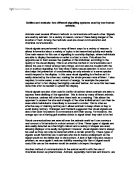The Cloning of Non-Human Animals: Playing God for all the Wrong Reasons
Name: Gunes Gereyhan
Student Number: 993857108
Teacher Assistant’s Name: Jenny McDermid
Lab Code: BM131
The Cloning of Non-Human Animals: Playing God for all the Wrong Reasons
The existence of humanity ultimately depends on our use of plants and animals to nourish us with their resources. The quality and quantity of the food that these living entities provide us with determine how healthy we will be and it has been the work of farmers and breeders, for many thousands of years, to engineer plants, but mostly animals, that provide us with the best of the best. For some time, the only way to do this was through selective breeding, a process by which animal and plant breeders pick, choose and mate organisms with the most desirable characteristics, such as resistance to disease, high growth rates and other characteristics that would produce an almost perfect specimen with never-ending resources. Although selective breeding seemed like the ultimate solution, there were many disadvantages to this method, including the selective process of choosing the right male and female animal for the job, the length of time it took the animals to mate (or the many attempts at artificial insemination before a fetus was created), the time it took young to be born and raised, and most importantly, the uncertainty in the expression of valued features in the offspring or the dilution of wanted traits. It seemed that the best way to reproduce a prized animal would be through cloning, and although in the past this idea seemed far fetched and maybe even impossible, the cloning of animals is now a darkening reality in the horizon of biotechnological research.







